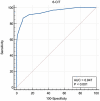Six-item cognitive impairment test (6-CIT)'s accuracy as a cognitive screening tool: best cut-off levels in emergency department setting
- PMID: 37547596
- PMCID: PMC10401263
- DOI: 10.3389/fmed.2023.1186502
Six-item cognitive impairment test (6-CIT)'s accuracy as a cognitive screening tool: best cut-off levels in emergency department setting
Abstract
Background: Nowadays, elderly patients represent a significant number of accesses to the Emergency Department (ED). Working rhythms do not allow to perform complete cognitive analysis, which would, however, be useful for the health care. This study aims to define the optimal cut-off values of the six-item Cognitive Impairment Test (6-CIT) as a cognitive screening tool in ED.
Methods: This study included 215 subjects, evaluated at the Emergency Department of the University Hospital of Monserrato, Cagliari, Italy, from July to December 2021. The accuracy of 6-CIT as a cognitive screening tool was assessed by comparison with Mini Mental State Examination (MMSE).
Results: The correlation coefficient between the two tests was -0.836 (CI: -0.87 to -0.79; p < 0.0001), and 6-CIT showed AUC = 0.947 (CI: 0.908-0.973; p < 0.0001). The 8/9 6-CIT cut-off score presented 86.76% sensitivity (CI: 76.4-93.8) and 91.84% specificity (CI: 86.2-95.7), and Youden index for this score was 0.786.
Conclusion: Our study demonstrates that 6-CIT is a reliable cognitive screening tool in ED, offering excellent sensitivity and specificity with a 8/9 points cut-off score.
Keywords: 6-item cognitive impairment test; aging; cognitive impairment; emergency department; mini mental state examination; screening.
Copyright © 2023 Salis, Pili, Collu, Serchisu, Laconi and Mandas.
Conflict of interest statement
The authors declare that the research was conducted in the absence of any commercial or financial relationships that could be construed as a potential conflict of interest.
Figures
References
LinkOut - more resources
Full Text Sources



